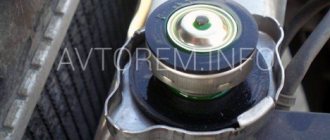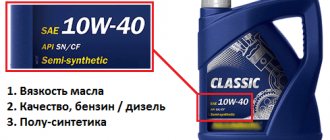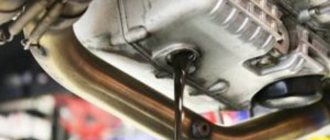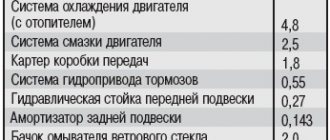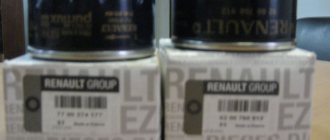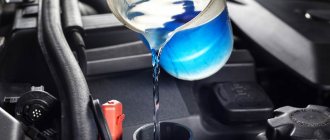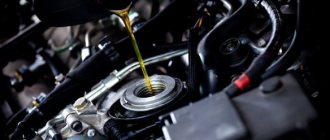Basic rules for adding antifreeze
Let us remind you that mixing different refrigerants is unacceptable in most cases, since at the output the mixed cocktail may precipitate, which will not disappear on its own, but will begin to systematically coke the thin radiator tubes and other delicate parts of the cooling system. Therefore, it is worth filling only with fluids indicated for use, which have received the approval of the car manufacturer, and only adding the same component that fills the already existing SOD with its base.
The question of how antifreeze or antifreeze behaves when added to ordinary water can be left open. Concentrates of these substances give excellent performance with water in certain acceptable proportions, again if distilled water is poured in, and not a composition of chlorine, sodium, magnesium and potassium, which often comes out of the tap.
Again, we remind you that the color of the coolant does not affect its composition in any way - green, blue, and red liquids can be compatible with each other, while liquids of the same color, for example, yellow, can have completely different structures, additives and bases.
Checking the antifreeze level
The amount of coolant can be checked in two ways:
- According to the light indicator on the panel;
- Visually under the hood in the coolant reservoir.
It is enough to check the antifreeze level monthly, unless emergency situations arise with deformation of the working container. If the temperature on the corresponding instrument panel scale exceeds, it is necessary to add antifreeze to the system. With regular replenishment of coolant, overheating of the power unit or its slow heating may occur. This indicates problems in the cooling system. The best way out of this situation would be to carry out diagnostics of the automotive unit in a specialized workshop.
It is worth considering that antifreeze is produced both in diluted and concentrated forms (see the article “How to dilute antifreeze concentrate”). When using a concentrate, it should be diluted with distilled water in proportions of 50/50. In addition, it is necessary to pay attention to the manufacturers' recommendations in terms of the ratio of liquid components.
Ensuring reliable and long-term operation of most vehicle components depends on various factors. Knowing how to properly add and pour antifreeze into the cooling system will allow you to adjust the operation of the power unit and prevent it from overheating. By following certain recommendations, it is quite possible to replace and replenish the refrigerant on your own.
How to add antifreeze to the cooling system?
Modern cars mainly use antifreeze; using its example, we will tell you how to properly fill and top up this substance for normal operation of the cooling system.
The most common mistake is pouring liquid into the radiator socket. Indeed, this unit has a filling hole, but only in those models that are subject to disassembly.
A tightly welded radiator system does not involve pouring and topping up directly; antifreeze enters it through the expansion tank, into which the coolant is mainly poured, then flowing evenly to all components of the cooling system.
By the way, when the coolant changes completely, the main reason for which is a simple change of brand or replacement of the old one with a new one, then collapsible radiator models are drained separately, with their own lower hole, and the rest of the liquid drains through an additional plug, which is sometimes covered with a protection on the bottom.
In this matter, the instructions are always helpful, since different car models may have their own modifications of the cooling system and non-standard drain and fill holes, especially for English-made cars. Otherwise, the procedure for filling antifreeze and other coolants can be divided into several simple steps. There is nothing complicated about this, so changing the refrigerant can be done independently.
Step-by-step instructions for replacing antifreeze
1. Buy the necessary high-quality antifreeze (for characteristics and indications, see the instructions for using the car, checking the manufacturer’s label).
2. Start the car and let it run without load for 10 minutes, then turn or set the interior heater to the maximum maximum position, in other words, turn on the heater to its fullest. After this, turn off the engine.
3. Drain old antifreeze from the entire cooling system.
To do this, it is better to position the car so that its front part is lower than the rear part, then the coolant will drain more actively from all the nooks and crannies. Then you need to turn the expansion tank plug so that excess pressure finds a way out (in some models you need to turn the plug on the radiator, and sometimes you need to turn two plugs at once). After the liquid in the system is not pumped, it will quickly cool down and will not allow you to get burned. As soon as the plug can be touched with an unprotected hand, it should be opened completely. Then also open the drain outlet at the bottom of the radiator, first replacing unnecessary containers in which the used antifreeze can later be disposed of.
4. Flushing the system.
After that. Once all the coolant has been completely drained, it is necessary to flush the cooling system.
This is done only when switching to new brands of antifreeze or in the case when the system has not undergone preventive maintenance for a long time. Distilled water perfectly washes away corrosive deposits and removes scale. If dirt has accumulated, then you should use special flushes for the cooling system, which will help remove the dirt.
If you decide to use ordinary water, then this procedure will have to be repeated two or three times. Namely...fill in the flush, close the taps, and perform this operation only on a cold engine. Then close all the plugs and run a flush for 10 - 15 minutes (or as indicated in the instructions) to clean the system. Then perform the first two steps in the same order as when draining the used antifreeze. If you want to save money, then the first flushing of a very dirty cooling system can be carried out under the pressure of ordinary water, and only then use special means or distilled water. On average, three washing lines are enough for the SOD to become like new. Yes, one more moment. It is at this time that you should check all gaskets, fittings and pipes for wear and replace them if necessary.
5. Fill with antifreeze. After cleaning the system, fresh working antifreeze, which was purchased earlier, is poured in.
Filling occurs into the neck of the radiator (only for collapsible models), but mainly into the expansion tank. By the way, you should carefully follow these steps and not confuse the expansion tank with the washer tank; they are usually located next to each other and are very similar to each other.
You should add antifreeze without haste, but also without stopping, which can cause air to enter the system; then you will have to pump it for a long time.
It is also necessary to monitor the fluid level when adding antifreeze:
- for the radiator - this is the lower mark (risk);
- for a drain barrel - the maximum, since the liquid will then disperse to all corners of the cooling system and its volume in the tank will decrease.
6. Vent the air. When the antifreeze injection is completed, the air should be bled from the system.
This is done by means of a tap - a screw located on the engine cylinder block. As soon as the first drops of liquid appear, this will be a signal that all the air has gone, and the tap can be turned back all the way.
After this final procedure, it is necessary to start the car’s engine again and let it run, allowing the accelerator to be applied five minutes after the start. Then turn off the car again, wait a few minutes and check the antifreeze level in the expansion tank. If necessary, add fluid to the required level. Also, after a complete replacement, the antifreeze should be checked every day for a week, since it is at this time that hidden problems in the system that were previously invisible can be identified.
Replacement steps
When you need to change the antifreeze in your car and the replacement time has come, remember that all actions are carried out exclusively on a cold engine. Under no circumstances should you carry out activities on a hot engine, as the temperature can reach 100 degrees.
To change the solution correctly, you should follow a few simple steps:
Prepare a container for draining waste material.
After draining, inspect the hoses, parts, and tank for damage, breaks or cracks. If you find damaged parts, replace them.
Flush the cooling system with a special liquid that removes rust and other stubborn formations. The cleaning agent is poured into the radiator, a little plain water is added to the tank so that it is filled to the very brim.
Start the engine and let it run until it warms up completely and reaches the standard operating temperature.
Turn off the power unit, let it cool, then drain it.
Fill the system with purified water and start the vehicle again. Leave it in working condition for 15-20 minutes.
Turn off the engine, give it time to cool completely and drain the residue again.
After the engine has completely cooled, you can add antifreeze.
Turn on the engine and heating in the cabin so that the coolant can be evenly distributed throughout the cooling system.
After 2-3 days, check the amount of solution and add more substance if necessary.
In order not to harm the vehicle, you should know how often to change it, since replacing antifreeze is carried out strictly according to the recommendations of the manufacturers. If you cannot carry out the prescribed manipulations yourself, seek qualified help from a car service center.
How to add antifreeze correctly?
Any addition of antifreeze and other refrigerants to the cooling system occurs only through the opening of the expansion tank.
To do this, you need to remove the cap and check for the presence of liquid. The minimum level should be alarming, and the maximum over the course of a month is beyond the norm, so it is better that there is a golden mean.
As mentioned above, you can only add antifreeze with the same composition, regardless of color, but it is better to use the same manufacturer, since there are differences in additives even for completely identical coolants, depending on the batch.
Topping up is carried out most often in the winter season. This is associated with the loss of fluid during cooling and heating (idling car, starting at idle). Such additions are normal and should not be alarmed. If antifreeze consumption becomes high, and a system check shows no malfunctions, then you should consider changing the refrigerant with a more resistant formula to freezing and expansion.
Is it possible to fill in antifreeze of a different brand, but of the same color?
There are no strict standards. There is no guarantee that a liquid of the same color as yours, but of a different brand, will be identical. Antifreeze from another manufacturer may be made on an incompatible base and contain incompatible additives, which will damage the cooling system. After making sure that the solution poured into the car and the solution you are purchasing are compatible, use a liquid of a different brand without being tied to the color.
What functions does coolant perform?
Before considering the procedure for replacing antifreeze, it is advisable to dwell on the functions of this fluid. The term antifreeze is commonly understood as a whole range of liquids that are designed to cool internal combustion power units. The coolers in question are also used in aircraft systems for cleaning glass.
A special feature of antifreeze is its resistance to low temperatures. The function of antifreeze is to prevent damage to parts caused by water freezing when the temperature drops.
Antifreezes demonstrate not only resistance to low temperatures, but also a minimal expansion coefficient. For example, during the freezing process, water increases its volume by up to 9%, while antifreeze increases its volume by up to 1.5%.
At the same time, adding coolant allows you to reduce the load on individual elements of the power unit. It reduces the likelihood of corrosion processes occurring. This is due to the presence of special additives in antifreeze.
Since the coolant constantly circulates in the system, it loses its performance characteristics over time. Water evaporates, and the cooler itself acquires a dark tint. This is because additives lose their properties over time.
Check the coolant in the car
To ensure your coolant is properly cooling your engine, it needs to be checked regularly, just like any other part of your car. This requires looking under the hood. In the engine compartment there is a – often white – plastic container, which is equipped with a scale, as well as two o and “MAX”. If the fluid level is between the two marks, there is no problem. If the fluid level is below the minimum level, coolant must be added. If the level exceeds the maximum recommended limit, something may be wrong. A visit to an auto repair shop is recommended.
In winter, in addition to the liquid level, the antifreeze concentration should also be checked by specialists. If the concentration is too low, antifreeze must be added.
The engine cooling system should be checked regularly. Since this does not work properly, the engine overheats. This leads to the combustion of the cylinder head gasket and complete engine damage.
What antifreeze should I use for my car?
Every car owner needs to know that they should only use the fluid that the car manufacturer offers. Therefore, if a car owner is interested in what to add to the cooling system, it is necessary to look at the reference literature, in particular, the car’s operating manual. In the manual you can find information about the use of certain brands of coolers. If we are talking about topping up, then you can only use the antifreeze that was used before. Ignoring this recommendation may result in damage to the vehicle's cooling system.
Important: antifreezes are classified according to certain brands. The corresponding marking is applied to the packaging container. The color of the coolant, contrary to popular belief, is not the main selection criterion.
The following types of coolant can be used for Hyundai Solaris:
The first composition from the listed list refers to hybrid substances. The second group (G-12) is represented by carbosilicate liquids, and the third - by the most modern compositions.
Important: in cases where it is necessary to add more than 1/3 of the total volume of the cooler, experts recommend completely replacing the antifreeze.
Thus, in the Hyundai Solaris, as well as in other car models, only certain types of coolant can be mixed. G-11 antifreeze must be mixed with G-11 and so on. At the same time, some types of coolants can be mixed. For example, G12+ can be poured into the cooling system if it uses G11 antifreeze. In other cases, mixing cooling compounds is prohibited. The same applies to mixing antifreeze and antifreeze. These two substances differ significantly in technical characteristics.
If a car owner buys antifreeze at a retail outlet, then you need to know that the compounds can be sold in the form of a concentrate and liquids ready for filling. The concentrate composition must not be poured into the coolant system. This substance must be diluted in accordance with the manufacturer's instructions. Typically, such information is printed directly on the packaging. If there is no information, it is recommended to check with the seller for details.
The Hyundai Solaris manufacturer recommends using antifreeze made on the basis of ethylene glycol. This composition is ideal for aluminum radiators.
Water and antifreeze: can the formulations be mixed?
The opinions of car owners regarding pouring water into the car’s cooling system and, in particular, antifreeze, differ. Most motorists claim that water can be mixed with antifreeze. There are some nuances:
- water must be distilled;
- You can add a small amount of water.
If the owner does not have the opportunity to fill with distilled water, then at least it should be well purified using a filtration system. Otherwise, the cooling system may become clogged. It is also possible that elements contained in untreated water will react with coolant additives.
No more than 200 ml of water can be poured into the cooling system. It is quite obvious that the use of large volumes will lead to dilution of the coolant and loss of its performance characteristics. In the summer this does not play a big role, but in winter it can cause the liquid to freeze. Adding water to antifreeze is allowed only in extreme cases, for example, on the road.
It is possible that the amount of coolant has decreased to a critical level. In such a situation, you can use water, of course, if antifreeze is not available.
Precautionary measures
Every motorist can add coolant to the system, but even in such a simple procedure it is necessary to adhere to a number of rules:
- You cannot unscrew the expansion tank cap “hot”; you must wait until the engine cools down, otherwise hot liquid under pressure may splash out of the container and cause a serious burn.
- Antifreeze is added to the system only when the engine is cold; hot and cold components must not be mixed.
- When adding water, only distilled water should be used in small quantities and only in emergency cases.
- If water has been added to the antifreeze, it must be completely replaced as soon as possible.
- Do not add more coolant than normal, because when it heats up, the pressure will splash it into the engine compartment.
- To avoid the formation of an air lock in the system, the car must be placed on a slope, so the expansion tank will be higher than the rest of the system elements. In this case, the liquid should be added in a small stream so that air has time to escape through the opening of the tank.
An insufficient level of antifreeze in the cooling system leads to overheating of the engine, which can cause many problems with the car. Therefore, it is necessary to regularly check the coolant level and add it to the system in a timely manner, taking into account the precautions described above.
Why can you add water to antifreeze?
If you pour a coolant of a different class into an antifreeze tank, this will lead to a change in the ratio of additives. For this reason, it is not recommended to experiment by mixing different classes of coolants. In turn, a small amount of water does not impair the performance parameters of the coolant. Essentially, water simply dilutes the antifreeze, reducing the volumetric amount of additives. At the same time, their percentage does not change.
In some cases, adding water to the antifreeze can lower the coolant's freezing point. At first glance, this statement may seem illogical, since it contradicts the laws of physics. But there is one caveat. Typically, a decrease in the coolant level in the system occurs as a result of water evaporation. Therefore, if a small amount of distilled or filtered water is added to the system, the technical parameters of the coolant will improve.
Next, we’ll look at how to add antifreeze to a car , what nuances exist, and also focus on the details of flushing the system.
Important: it is recommended to fill the system with no more than 200 ml of water. It is recommended to perform the procedure in the summer, when water evaporation occurs most intensely.
It is not advisable to dilute antifreeze during the winter season. It is also worth noting that approximately 3/4 of any coolant consists of ordinary water.
How to properly add antifreeze to a car?
Next, we will focus on the frequency of filling coolant. Antifreeze must be added in the following cases:
- the expansion tank valve is activated;
- coolant level has decreased;
- the coolant is unsuitable for further use.
If the valve on the expansion tank periodically operates, this indicates that the antifreeze is not performing its functions. That is, the liquid is not able to absorb the required amount of heat.
Motorists often notice that the level of coolant in the system has decreased significantly. Sometimes this is due to water evaporation. In other cases, there is a banal leak. Most often, leakage occurs as a result of depressurization of pipes, radiator and a number of connections. Much less often, a leak occurs as a result of damage to the expansion tank.
There are two marks on the expansion tank of any vehicle indicating the minimum and maximum permissible levels of antifreeze.
The first letters of the words LOW and FULL are indicated on the expansion tank of the Hyundai Solaris. In the first case, the L label indicates the minimum acceptable level. Accordingly, mark F indicates that the maximum permissible amount of antifreeze is poured into the tank. Other vehicles may use completely different labels, such as minimum and maximum.
If the car owner has recently poured coolant into the system, and the level has dropped significantly, this indicates a leak. In this case, it is necessary to look for the location of the leak.
How to do it yourself
To avoid contacting service station workers, you can learn how to properly add antifreeze. Follow the rules written above and complete the following points.
- Wrap your hand in a rag (wear gloves) and remove the expansion tank cap. Reduce the pressure by turning the cap one turn. As soon as it falls, remove the lid completely.
- Add liquid to the tank to medium level.
- We turn on the engine of the car. Let's give it time to work. Pay attention to how much antifreeze is available. If necessary, fill the tank.
- The antifreeze should be at the level of the lower end of the radiator filler neck.
- We continue to add liquid. We do this carefully, without spilling.
- Close the lid.
To perform this procedure, you need to first prepare the cooler itself, distilled water with which you will dilute the cooler, a rag (gloves) and an expansion tank.
Antifreeze functions
Before we proceed directly to the description of the procedure for replacing the coolant, I would like to dwell on the functions that it performs. This is necessary so that in the future it is clear the purpose of the operations performed by the car owner, as well as the factors that need to be feared.
So, the first and main task of antifreeze is to cool the power unit of the car . However, in addition, the coolant reduces the load on individual engine parts and also prevents corrosion on their surfaces. This is ensured by the presence of special additives and additives in the liquid.
Antifreeze or antifreeze?
Many people believe that TOSOL or Antifreeze cannot be used in the same car, that it is necessary to fill in antifreeze as cooling. So what is better to choose and what the difference is, let’s look into it in more detail.
Due to constant circulation in the system, antifreeze gradually loses its properties. More precisely, they are lost by the additives included in its composition, and water evaporates from the liquid. The composition itself becomes darker and loses its heat-absorbing properties.
Recommendations from manufacturers
Manufacturers always indicate the recommended period for using the liquid on the label. At the end of the specified period, it should be changed, since its unique properties are lost.
How often should you change the antifreeze in your car? Replacement intervals depend on the manufacturing technology of the product and its standard. Automotive industry giant Volkswagen proposed its own classification, which was picked up and actively used by other companies:
G11 (green) - traditional solutions that consist of inorganic silicate compounds and other synthetic elements. The advantage of this class of products is the formation of a special protective layer on engine parts, which prevents the development of corrosion. When using a technical solution longer than the prescribed period, the protective layer precipitates, the level of protection deteriorates, and flakes clog system components. The update interval recommended by the manufacturer is 24 months. Antifreeze has similar qualities, so the recommended period of use is also 2 years.
G12 (red/orange) - standard designating coolants for the manufacture of which organic acids were used. It differs from the traditional type in its heat transfer properties and targeted effect on the source of corrosion, preventing its spread. After the expiration of the permissible service life, the substance loses its properties too quickly, so they must be drained every 5 years.
G13 (yellow) – new generation of (lobrid) coolants. The main element of this class of solution is propylene glycol - an environmentally friendly and reliable component. According to the principle of operation, antifreezes of this class are similar to the G12 standard. Replacements in a car are carried out every 5-10 years, but some popular companies claim that their product does not lose its properties throughout the entire life of the cooling system.
Choosing antifreeze to replace
Before adding antifreeze , you need to decide on its type. Remember that, ideally, you should always only use the coolant recommended by your vehicle's manufacturer . You will find detailed information in the manual or reference literature. In most cases, the use of coolants of different classes and brands is allowed. And when topping up, use only the one that was filled in earlier. Failure to comply with this rule may result in a malfunction of the cooling system.
As for the Hyundai Solaris car, the following types of antifreeze can be used for it:
- G-11. Such compositions belong to the hybrid group - hybr >If it is necessary to add more than 30% of the total volume, then it is better not to add antifreeze, but to completely fill in new fluid.
Accordingly, only hybrids can be mixed with hybrids, carboxylates with carboxylates, and lobrides with lobrides. Mixing antifreeze of different classes is strictly prohibited . The only exception is G12+ class antifreezes, which can be added to G11 and G12 fluids. Also, you cannot add domestic “Antifreeze” to antifreeze , since their chemical compositions are very different.
Remember that antifreeze is sold in stores in two formulations - completely ready for pouring into the cooling system and as a concentrate. Pay attention to this, since pure concentrate cannot be added to the existing coolant in the car system . Even if they belong to the same class. Therefore, if you bought concentrated antifreeze, dilute it in accordance with the instructions on the package. The choice of solution composition is usually dictated by the freezing point.
Under what circumstances can you still add water to the coolant?
Despite the strictest prohibitions and restrictions, there are situations that leave no choice. It happens that the antifreeze has leaked, and there is simply nowhere to get a new one. I need to drive, but I really, really don’t want to damage the car. Under such circumstances, it will be possible to dilute the coolant with water. Here it is important to strictly follow one rule - the volume of water poured should not exceed the volume of antifreeze.
If the antifreeze has completely leaked out, then there is definitely no choice and you can fill the water completely. This will allow you to get to the nearest repair shop, but you should move very slowly.
Is it possible to add water to antifreeze?
There are many disputes and opinions regarding the possibility of adding water to antifreeze. Let us take the liberty of saying that it is possible to add water to the coolant, but there are a couple of important points.
Antifreeze crystallization temperature
Firstly, the water must be distilled or at least well purified using filters. This is necessary so that the elements present in the liquid do not clog the engine cooling system and do not enter into a chemical reaction with the additives and additives present in the antifreeze.
Secondly, you can add very little water - 100.200 ml . Otherwise, it will greatly dilute the coolant, and the latter will lose its performance properties (critical in winter). Therefore, you can use water as a top-up liquid only in extreme cases, when the level in the system has dropped to a critical level, and you do not have similar antifreeze on hand.
Now let's look in more detail at the arguments that suggest that water can still be mixed with antifreeze:
- Water added to antifreeze will not impair its performance. Unlike coolants belonging to other classes listed above. This statement can be made on the basis that the properties of antifreeze largely depend on the volumetric ratios of the additives included in its composition. If they are violated (which happens when mixing “coolants” of different types), then the mentioned properties are reduced to “no”. Water proportionally reduces their volumetric quantity, that is, their ratio remains the same.
- Contrary to popular belief, adding water to antifreeze will lower the freezing point of the coolant. This statement can be made on the basis that the reduction in the volume of coolant in the system occurs mainly due to the evaporation of water. This process occurs when the safety valve on the expansion tank opens. Water evaporates first, and only then ethylene glycol. Accordingly, if you add water, the freezing temperature will be restored.
The rationale for adding water also stems from the fact that most antifreezes themselves are about 70% water. This is largely responsible for the evaporation of liquid in the summer. But remember that in winter it is not recommended to dilute antifreeze too much.
Errors when handling antifreeze and their consequences
When checking the antifreeze level in the tank, it often becomes necessary to top it up. In winter, it evaporates intensely, so you need to check its condition more often at this time. At low temperatures, all elements of the expansion tank partially lose their tightness, as the properties of rubber and plastic change. This is fraught with antifreeze leaks. As a rule, they are not fatal, but this does not eliminate the need to monitor the process and timely add a new portion of antifreeze.
Typical mistakes when handling antifreeze are:
- the plug is unscrewed “hot”, without waiting for the engine to cool down;
- there is no rag on the tank (if the tank has not had time to cool completely, this can be dangerous);
- fresh liquid is added “to the hot one;
- antifreeze is poured into an empty container;
- do not use distilled water, but ordinary water when topping up.
No matter what frivolous “experienced” drivers say, you cannot unscrew the cap when the engine is hot. Even if the brave souls are constantly lucky, it is not a fact that next time everything will be exactly the same. Since the pressure in a closed system is high, when you unscrew the cap “hot,” the liquid may splash out onto your hands or even onto your face. Serious burns always leave scars, so there is no need to rush and tempt fate.
There are situations when there is no time to wait until the system has completely cooled down. In this case, place a rag over the lid before unscrewing. It will close the drain hole and prevent a strong splash of antifreeze, but will not be able to protect against splashes. To avoid injury, it is better, however, to wait until the engine has completely cooled down and only then get to work.
The fluid level in the expansion tank cannot be checked “hot”. Never add new antifreeze until the system has completely cooled down. Remember that when warming up, there is a risk of overfilling the maximum level, squeezing antifreeze into the space under the hood of the car and damaging its internal parts.
The tank should not be allowed to become completely empty. When adding antifreeze to an empty container, air may enter the system along with it. The engine will overheat and fail. If the tank still turns out to be empty, fresh antifreeze must be filled at a service station.
All instructions for using antifreeze state that in the absence of a suitable liquid, distilled water can be added. Ordinary water is added only in emergency cases, and when it becomes possible to contact a service station, this must be done as quickly as possible. You cannot constantly use plain water: an increased content of mineral deposits in it will lead to the appearance of rust inside the engine and other elements of the car.
When to add antifreeze
Checking the coolant level
The next interesting question is how often to add antifreeze, and in what cases this procedure should be performed. Let's look at this information in more detail. There are several reasons why topping up is necessary. In particular:
- Visible decrease in the level of antifreeze in the system . This phenomenon can occur at any time due to a leak in the body of the expansion tank, radiator, pipes, connections, and so on. There are two marks on the expansion tank of the Hyundai Solaris car - L and F (LOW and FULL, respectively, low and high level). If the level drops below the L mark, then it is necessary to add antifreeze. On other machines, instead of the mentioned marks, there may be other marks, but their essence will be similar.
Low coolant level indicator
Remember that if there is insufficient amount of coolant, an additional load is placed on it, which, firstly, it is not always able to cope with, and secondly, the properties of antifreeze in this case are lost much faster. In addition, in such a situation, the coolant may not fully cope with the tasks assigned to it, and accordingly, the engine will overheat (this may increase oil consumption and other unpleasant consequences). This concludes the theoretical part of the material, and we move on to practice, that is, directly to topping up.
What can be added and in what quantity?
There are several types of antifreeze. You cannot mix them with each other, but you must add them strictly according to the marks. There is an opinion among car enthusiasts that some types of coolants are compatible with each other in terms of their chemical composition, but it’s still not worth taking risks and mixing them. To avoid unpleasant situations and machine breakdowns, use one type of fluid and buy it from trusted manufacturers.
When adding any water (regular or distilled), antifreeze may freeze in winter. If there is no fresh portion of antifreeze, add water only in the warm season. Never dilute the coolant with other chemicals. As a last resort, use plain water, but do not overuse it.
The lack of antifreeze in the tank can take the driver by surprise before the winter cold. To prevent this from happening, before the winter season, completely change the cooler and fill in a new one.
You need to spend time monitoring the condition of the coolant, otherwise it can be fraught with bad consequences for the car. If you check the antifreeze level in a timely manner, the engine will work properly, and the car will serve you for many years.
How to add antifreeze correctly
We will consider the procedure using the example of the mentioned Hyundai Solaris car. However, most of the above actions and reasoning will be valid for most other machines. The differences relate only to the location of individual components and mechanisms (in particular, the expansion tank).
So, in the Hyundai Solaris, the expansion tank of the cooling system is located on the right side of the engine compartment, directly on the system fan casing. The procedure itself is performed according to the following algorithm:
Location of the coolant expansion tank for Hyundai Solaris
- It is advisable to install the machine on a slope so that its front part is higher. This is done so that the air leaves the system without obstruction. However, if you plan to add a small amount of liquid, then this recommendation can be ignored.
- You need to take a rag, cover the expansion tank cap with it, and carefully unscrew it. This is necessary in order to protect clothing and skin from possible splashes if there is excess pressure in the system.
- Add coolant directly. Remember that it is necessary to top up in a thin stream so that at the same time the air contained there comes out of the system and an air lock does not form. That is, in such a way that when adding, air bubbles do not form on the surface of the liquid. Otherwise, you will need to “drive out” the traffic jam, which is associated with additional problems.
- Add liquid to a level approximately ⅔ of the tank volume , closer to the maximum mark. After this, start the engine and let it run for 3.5 minutes. During this time, the antifreeze will spread throughout the system and its level in the tank may drop.
- If this happens, the topping up procedure must be repeated, and then start the engine again. This must be done until after the next engine start the fluid level remains at the same level (in most cases, if you need to add a small amount of fluid, one such cycle will be enough).
- After completing the procedure, use a rag to get rid of possible antifreeze splashes on the surface of the tank or other elements in the engine compartment, and tighten the tank cap.
We recommend that you do not throw away the antifreeze canister . If there is still liquid left, you can add it again in the future. And if the canister remains empty, you will always have at hand information about what brand of coolant was used. Accordingly, in the future you will be able to buy a new, similar composition.
Refrigerant replacement
Every driver who cares about the condition of his car should know how to properly add and pour antifreeze into the cooling system. Antifreeze should be selected in accordance with the car manufacturer's recommendations. When choosing a coolant, you should not rely on its color. Currently, this is more of a marketing ploy than a distinctive characteristic of the refrigerant.
After activating the power unit for a few minutes, you need to move the heater controls to the maximum position. It is advisable to park the car on a slope, with the front part up, which will allow the system to be freed as much as possible from old antifreeze. After the engine has cooled, unscrew the cap of the expansion tank to relieve pressure and open the fluid drain valve located at the bottom of the radiator near the oil filter.
If it is necessary to flush the system, after draining the coolant and closing the taps, distilled water is poured into it, and the engine is turned on for several minutes to pump the SOD. The procedure is repeated 2-3 times until clean water without impurities is drained from the system. New antifreeze is filled through the radiator filler neck and into the expansion tank. When filling the coolant for the first time, you can fill it to the maximum level line. After start-up, the refrigerant will disperse through the working pipes and the entire system.
Then you should bleed off excess air through the tap on the cylinder block until condensation appears on it. The tap is screwed in all the way, the engine is turned on for a few minutes, the antifreeze level is re-checked, and, if necessary, replenished to normal.
Flushing the system
The need to flush the car's cooling system may arise in the following cases:
- The antifreeze used has become very black and/or thickened. In this case, it must be replaced completely, despite its specified service life. This fact can be caused by two main reasons - either you forgot to change the fluid according to the regulations, or you bought a fake.
- If it is necessary to add more than 30% of antifreeze to the existing volume. In this case, the existing “coolant” must be drained and the system flushed using distilled or ordinary water. You can also use other, more effective means for this.
How to flush the engine cooling system
There are at least 4 ways to flush the engine cooling system. One of them is to rinse the outer part with ordinary water, but it is better to rinse the inside with a solution of citric acid or a special product.
Results
Adding coolant is a simple procedure, and even an inexperienced car owner can handle it. The main thing is to follow safety precautions (perform the procedure with a cold engine and cooling system), and also choose the right antifreeze that you plan to add. Try to ensure that no air pockets form during the topping process. While operating the car, regularly monitor the coolant level, and if necessary, do not forget to add it or change it completely.
Coolant: Here's how it cools the engine
If the engine actually starts, it gets hot. Because combustion of fuel converts chemical energy into friction, kinetic energy and - for the most part - heat. In the engine cooling system, where the coolant is also located, excess heat is released to the outside air.
Initially, heat is transferred to the engine components. It is then released into the coolant and transferred to the refrigerator through the coolant circulation. From there it is eventually discharged to the outside. To maintain a constant coolant temperature and therefore engine temperature, coolant flow is controlled by a thermostat.
